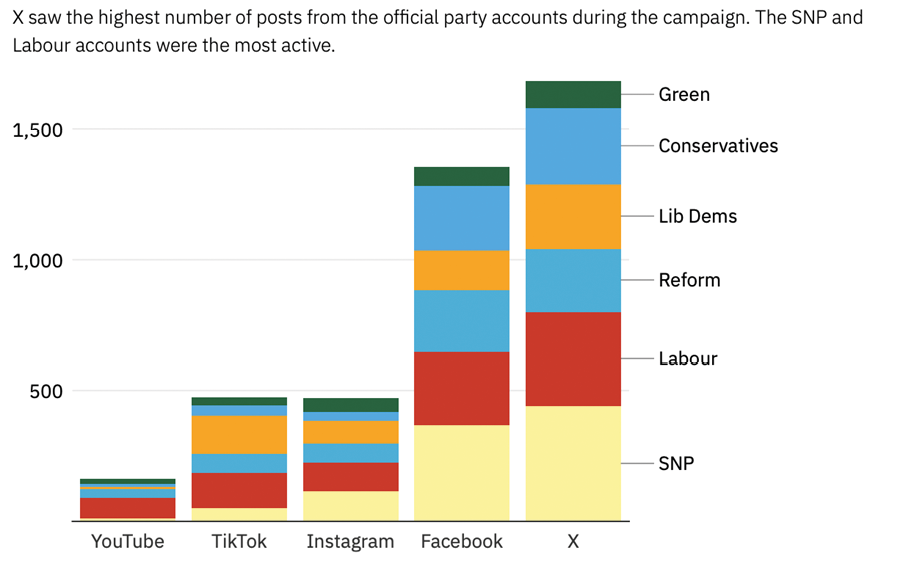
Dr Richard Fletcher
Director of Research, Reuters Institute for the Study of Journalism, University of Oxford. He is primarily interested in global trends in news consumption, comparative media research, and the use of technology by journalists and news organizations. Richard is lead researcher and co-author of the Digital News Report – the world’s largest annual survey of global news use.
@richrdfletcher
Email: richard.fletcher@politics.ox.ac.uk

UK Election 2024
Section 6: The digital campaign
62. Local news and information on candidates was insufficient (Dr Martin Moore, Dr Gordon Neil Ramsay)
63. The Al election that wasn’t – yet (Prof Helen Margetts)
64. Al-generated images: how citizens depicted politicians and society (Niamh Cashell)
65. The threat to democracy that wasn’t? Four types of Al-generated synthetic media in the General Election (Dr Liam McLoughlin)
66. Shitposting meets Generative Artificial Intelligence and ‘deep fakes’ at the 2024 General Election (Dr Rosalynd Southern)
67. Shitposting the General Election: why this campaign felt like one long meme (SE Harman, Dr Matthew Wall)
68. Winning voters’ hearts and minds… through reels and memes?! How #GE24 unfolded on TikTok (Dr Aljosha Karim Schapals)
69. Debating the election in “Non-political” Third Spaces: the case of Gransnet (Prof Scott Wright et al)
70. Which social networks did political parties use most in 2024? (Dr Richard Fletcher)
71. Facebook’s role in the General Election: still relevant in a more fragmented information environment (Prof Andrea Carson, Dr Felix M. Simon)
72. Farage on TikTok: the perfect populist platform (Prof Karin Wahl-Jorgensen)
In recent years much ink has been spilled over the possible influence of social media on UK general election results. This year—perhaps because the was little doubt about which party would emerge victorious, or because the focus has shifted to the influence of AI—there’s been much less talk about social media.
Reflecting the fact that social media use has become more fragmented since the last general election in 2019, some commentators have, however, speculated about where in cyberspace the campaign is being fought. Is the battle taking place on private messaging apps like WhatsApp? Or are parties fighting for attention on newer, more video-based social networks like TikTok, perhaps at the expense of ‘legacy’ social networks like Facebook and X?
To explore this, I analysed the number of posts from official party accounts during the official General Election campaign (30th May to 4th June inclusive). I looked at the six parties with the highest vote share (Labour, Conservative, Lib Dem, Reform, Green, SNP) on the five most popular social networks in the UK (excluding messaging apps) according to the 2024 Reuters Institute Digital News Report (Facebook, YouTube, X, Instagram and TikTok).
This data, of course, does not tell the full story. It does not capture the broader political conversation, or that parties themselves are active on social media in other ways, often across multiple accounts (e.g., those of party leaders or regional divisions). And it says nothing about the important issue of political advertising. But it does provide a broad sense of where parties are putting their resources, and where they think they are best able to reach potential voters.
Despite the buzz around newer networks like TikTok, the results show that parties were (still) most active on ‘legacy’ social networks like X, followed by Facebook (Figure 1). As well as having more posts in total, all six parties individually posted more to X than on any other platform. This focus on X is perhaps unsurprising given that it is still home to a disproportionately large number of users interested in news and politics. But the way the parties prioritised Facebook is perhaps surprising, given its recent efforts to deprioritise news and politics in people’s feeds. Though, on the other hand, it remains the most widely used social network for news in the UK.

Instagram was less widely used by the main parties, but on average they each still posted to it 2-3 times per day during the campaign. This puts it level with TikTok, which was used by the parties for the first time during a UK general election campaign. YouTube, although relatively popular for news in the UK, was rarely used. However, given its huge user base, parties may still have chosen to use it more for political advertising.
Focussing on the parties, Figure 1 also shows that Labour and the SNP were the most active on social media overall—each making a total of just under 1000 social media posts each during the campaign (which is about 30 posts per day). The SNP were the most active individual party on Facebook, Instagram and Twitter. Labour were the most active party on YouTube, and the Lib Dems were the most active party on TikTok. The Conservatives posted a lot to Facebook and X, but rarely on other networks. The Greens posted relatively little, but fairly evenly across networks.
To some extent, the results are aligned with the more fragmented patterns of social media use we see in 2024. No one social network is used by everyone, and the use of specific networks is influenced by people’s age and interests. Therefore, parties (much like news organisations) recognise that they need to communicate across multiple platforms to reach the public. But, it seems, they still prioritise networks with large, politically interested userbases, while also experimenting with newer networks.
There is, however, a potentially more interesting trend under the surface. Posting from the main political parties (at least on Facebook and Instagram, where there is reliable past data from CrowdTangle) was down considerably compared to the 2019 campaign. On Facebook, the average number of posts per day across all parties was down by around 42%, while on Instagram posting fell by around 24%. This isn’t true for every individual party—the Lib Dems upped their use of Instagram, for example. And, of course, new networks like TikTok may be picking up some of the slack (though TikTok alone simply isn’t used enough to fully compensate for the Facebook decline). But it nonetheless begs the question—given the parallel decline of news participation on social media in recent years—of whether the importance of social media in election campaigns starting to wane? Let’s return to this question in 2029.
